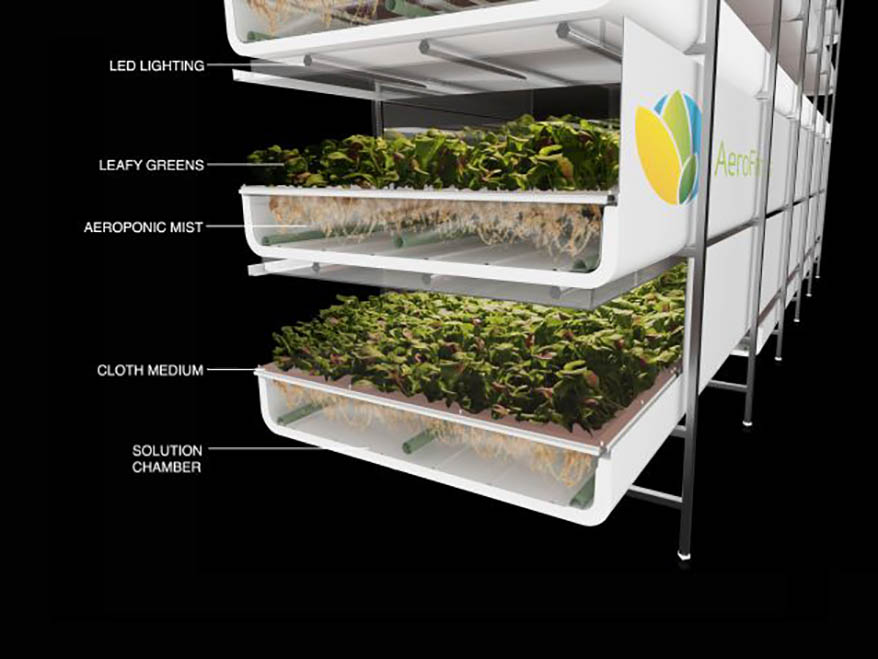Uncategorized
Can Vertical Farming Feed The World?
This past week construction began on the world's largest vertical farm. Vertical farming is a system of food production that takes place indoors, uses no soil, very little water, and takes advantage of vertical space. By using hydroponics, farmer's can provide nutrient rich water to the roots of the plants, without needing heavy soil. Without soil, farmers can grow the plants indoors, significantly reducing pest problems and allowing the farmers to stack the plants in trays. Vertical farms may use sun light, LED lights, or a combination of the two.
The increased growing space, pest reduction, and water efficiency of vertical farming shows promising signs that it can feed the world while avoiding many of the problems of land-based agriculture. And that's just what AeroFarms hopes to demonstrate in their new facility in Newark, New Jersey. Click here to learn more about vertical farming.
The farm is one of many industrial buildings in the Ironbound community of Newark where former factories and warehouses are being rehabilitated into new uses. The groundbreaking was yesterday, and when finished, the 69,000 square foot space will be the largest indoor vertical farm in the world.
The technology for the farm will come from a company called AeroFarms, which uses tall towers of LED-lit aeroponic trays to grow herbs and leafy greens. AeroFarms claims that their method is 75 times more productive than a traditional outdoor farm would be per square-foot. And because it’s indoors, it uses no pesticides.
However, vertical farming is not without its critics. Many are concerned that the energy necessary to run the systems would make the produce too expensive for the average consumer. Others question whether the plants can be as nutritious as soil grown produce without the soil microorganisms that help the plants absorb nutrients.
What do you think about vertical farming? Is it the wave of the future, or just another fad? Let us know in the comments.
Vertical Farming Can Be Done Anywhere with the Help of “Growing Up”
Do It Yourself Vertical Garden Guide from Survival Life
Vertical and Container Gardening: Charts and Images
-

 Paracord Projects1 year ago
Paracord Projects1 year agoParacord Projects | 36 Cool Paracord Ideas For Your Paracord Survival Projects
-

 Paracord Projects1 year ago
Paracord Projects1 year agoHow To Make Paracord Survival Bracelets | DIY Survival Prepping
-

 Medical Care1 year ago
Medical Care1 year ago21 Home Remedies For Toothache Pain Relief
-

 Knife Laws1 year ago
Knife Laws1 year agoAre Switchblades Legal? Knife Laws By State
-

 Do It Yourself1 year ago
Do It Yourself1 year agoSurvival DIY: How To Melt Aluminum Cans For Casting






RyDaddy
July 16, 2015 at 9:59 AM
I think any soil microorganisms that would be beneficial could be added or faked in the nutrient-enhanced water, so, yeah, I think vertical farming CAN feed the world.
Rosemary Meeks
July 16, 2015 at 10:21 AM
How are you going to do this with such a shortage of potable water? The shortage is growing in several states now. I believe that water will become one of the most coveted substances on earth one day.
Michael boyd
July 16, 2015 at 12:15 PM
It has always been one of the problems with hydroponic farming , a lack vitamins and nutrients in the vegetables it’s not just the nutrients either hydroponic Vega tables lack much of the flavor. Add to that clean drinking water is getting harder to obtain and hydroponic gardening is a recipe for disaster. Wanna increase productivity the soil rotation and heritage seeds not ” GMO” are the real answer.
ProfessorPBZ
July 16, 2015 at 6:56 PM
No Pesticides is is a great reason alone for doing it.
‘
Pingback: Terrace Farming On Your Homestead | Types Of Farming